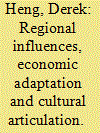|
|
|
Sort Order |
|
|
|
Items / Page
|
|
|
|
|
|
|
| Srl | Item |
| 1 |
ID:
173379


|
|
|
|
|
| Summary/Abstract |
Ancient Singapore is often discussed exclusive of its cultural and historical context, a backward projection of the modern, independent city-state. Temasek is understood mainly in terms of being a maritime entrepôt with extensive trade connections. This research is interested in Temasek as a proto-historic Malay port-city, namely its social, political and economic organisation. It is an aspect of early Singapore, and of the Malay World, in general, we know very little about. However, more than three decades of archaeology have provided a wealth of data related to daily life in the settlement and the data has provided hints of a diverse sociocultural landscape. This study focuses on the relationship between metal production and social organisation, and employs a conceptual and interpretative framework that is both multidisciplinary and cross-cultural. Craft production is as much a social and political phenomenon as an economic and technological one, and studies of production systems can shed light on issues of power and control over resources and labour. The data suggest the presence of a social stratum that could generate and mobilise resources independent of the ruling elite. Metals were rare and valuable commodities during this period, however, the ruling class in Temasek did not appear to control nor restrict production of iron and copper-based goods as it did with glass. The results are by no means the final word on ancient Singapore or Malay society. Instead it provides a provisional model that can be tested with archaeological data, refined and expanded as more material becomes available.
|
|
|
|
|
|
|
|
|
|
|
|
|
|
|
|
| 2 |
ID:
173378


|
|
|
|
|
| Summary/Abstract |
Studies on the international history of fourteenth-century Singapore have been hitherto limited to external trade conducted by local inhabitants, and material consumption patterns that this trade enabled them to develop. Broader regional cultural influences have been postulated though not clearly demonstrated, given scant textual records and limited material culture remains. This article seeks to examine the external influences, adaptation and assimilation in the production and consumption of fourteenth-century Singapore. In particular, it looks at three aspects of Singapore's pre-colonial existence — modes of economic production, patterns of consumption of international products, and the articulation of high culture vis-à-vis external entities. By examining available archaeological, epigraphic, art historical and cartographic data from the fourteenth through the nineteenth centuries, this article postulates how distinct consumption patterns may have developed among different riverside populations living north of the Singapore River. This study also questions the common view that Singapore developed as a cosmopolitan port-city only after the advent of British colonialism, demonstrating that its diversity and openness was likely a feature centuries before.
|
|
|
|
|
|
|
|
|
|
|
|
|
|
|
|
|
|
|
|
|